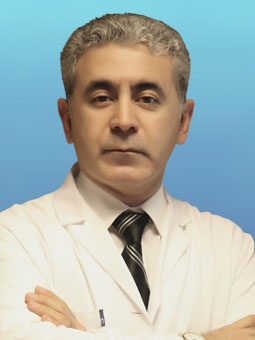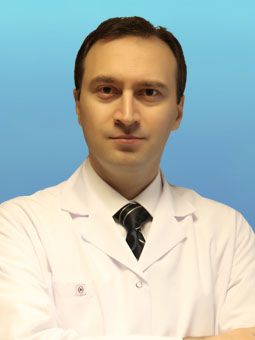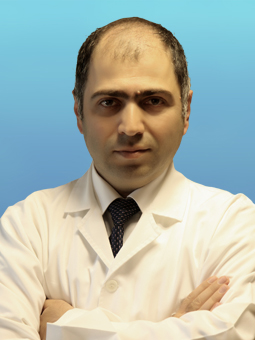
EYE
The cornea should be smooth and each axis should be in the same radius. The cornea being more or less curved in a certain axis, revealing the astigmatic defect. The image is not clear in far or near sight and patient sees objects shadowed.
E-Presbyopia
It is usually a problem of lack of clear near sight that starts after 40 years of age because of lack of elasticity of the eye lens in natural conditions. Unlike myopia, hypermetropia and astigmatism, laser treatment is not possible ...
The first step to a healthy and happy life ...
Vision is the most important element that connects people with their life. For this reason, regular eye examination is one of the most important steps to be taken for a healthy life. And it should not be forgotten that ocular eye diseases and illnesses can only be revealed by the eye doctor. Even if an adult over 40 years old does not have any complaints, he/she should be examined once a year, even if he/she does not use or use eyeglasses. In children, this may be more frequent like every 6 months, or more frequent even in some special cases, according to the doctor's recommendation. 3 years of age is ideal for first eye examination for a child without any complaints.
At the Nisa Hospital, eye examinations are carried out meticulously and in great detail by the latest technological equipment and a specialist staff.
- Visual Sharpness Test
Our ability to see fine details is measured by tests that consist of increasingly shrinking letters.
- Eyeglasses Need Examination
We can not see clearly due to the refractive error of the eyes.
At Nisa Hospital, all refractive error examinations are made with the most advanced technological computer equipped devices.
- Examination of the eyelids
The eyelids, lacrimal glands, tear discharge system and the situation around the eyes are examined.
- Examination of Eye Muscles
The inner muscles of the eye control the movement of the pupil and are directly related to the brain. The outer muscles of the eye also allow the eyes to stay parallel. The condition of eye muscles is determined in strabismus and double vision examinations.
- Eye Tension Measurement
Intraocular pressure is detected by tonometry test.
- Biomicroscopic examination
The cornea, iris, lens and vitreous details are examined and the cataract can be diagnosed before symptom onset.
- Eye Ground Examination
With this examination, signs of retinal detachment, glaucoma, hypertension, brain tumor and various diseases of the body can be detected.
It should not be forgotten; During the ophthalmologic examination, the likelihood of liver disease, sugar, brain tumors, AIDS and many other diseases can be determined or diagnosed.
The modern treatment methods applied at the Nisa Hospital after the examination and applied with the most advanced technology will ensure your health and happiness.
The rays reflected from the objects we see are first focused on the 'retina' layer of the nerve fibers located at the back of the eye by breaking through the transparent layer (cornea) in front of the eye and the lens inside. The image of the object that forms in the retina is transmitted to the visual center of the brain via the optic nerve and the vision occurs.
Loss of transparency of the cataract eye lens (lens) and opacification of the cataract occurs as a result. The eye lens lies behind the colored layer and allows the incoming light to focus on the receptor cells on the nerve layer. When the lens is opaque and the light transmittance is decreased, that is, when the cataract develops, the receiver will not reach the cells as much as the light and the image, and the vision will decrease.
- CAUSES
Aging, genetic discomfort, intraocular reactions, impact on the eye, intraocular microbial disorders, etc. may cause cataracts, but it is the most common one is the age-related cataract. In this case, with the advancing age, there is a cell increase in the lens and the metabolism goes bad, the vision decreases with time ...
- TREATMENT METHOD
Cataract's only treatment is surgery. There is no treatment method other than surgery
There is no need to wait for cataracts to mature so that the eye can be operated with the methods and technical devices applied at the Nisa Hospital Eye Center. There is a high rate of increase in the patients' vision after surgery.
The main operation is to remove the opaque lens from the eye and replace it with a new one. This lens called the 'intraocular lens' is permanent in the eye. It does all the functions of the old lens and the patient does not feel the presence of it. Two different methods are used for placement of the intraocular lens:
Cataract operation with sutures and PHACO.
- Sutured Cataract Operation When this method is used, cataract should be matured. Sutures are used and those should be removed after a while. In this technique, the anatomical structure of the eye is weakened due to cutting, astigmatism may occur due to stitching, and it takes a while before the visual improvement.
- PHACO (phacoemulsification technique) cataract surgery
In this technique, the eye is penetrated through a small cut and the surgery is completed without the sutures. For this reason it is known as 'sutureless' or 'laser' cataract surgery among the public. Delay in cataract surgery can even cause irreversible blindness. Thanks to PHACO, there is no need to wait for cataracts to mature for surgery.
Latest technology in cataract...
In cataract surgeries with PHACO there is no general or local anesthesia except for special cases. Patient is prepared for operation by putting drops that only numb the eye. After 4-5 application of drops, operation may be started.
1st Stage:
Drops which numb the surface of the eye is applied 4-5 times. The area where the cornea, which is the transparent part of the eye, and the sclera that forms the white part are combined, is the first incision place in cataract surgery. Eye is reached With a special incision of approx. 3 mm. From this incision, a jelly-like substance with eye-protecting properties is filled into the eye. This material provides safe working within the eye. Behind the colored part of the eye is the lens of the eye (tissue called cataract when opaque). Cataract is found in a membrane. A round window opens on the front of the cataract membrane with the aid of a cystotome device.
2nd Stage:
This membrane, which is in the middle, is separated from the cataract nucleus and from the shell (cortex) with fluid. With a special injector, the liquid from behind the sides of the membrane separates the membrane from the other parts. Thus, the cataract becomes free within its own membrane.
3rd Stage:
Clearing process of the cataract is started During the process, a device shortly called PHACO is used. This device uses ultrasonic power, thus sound waves. This device with 2.7mm diameter crushes the cataract and sucks them inside, and fills the empty space with almost natural fluid.
4th. Stage:
In hard cataracts, the core is crushed by a second tool. Hard cataracts are broken down into smaller pieces to make cleaning easier.
5th Stage:
After the core, which is a large part of the cataract, is cleaned, the cortex is cleaned. This tissue is a type of inner shell attached to the inner surface of the membrane. It is ensured that the natural membrane of cataract becomes an empty clean bag.
6th Stage:
Intraocular area is cleaned of cataract. For safe operation, refilled with jelly substance. This substance fills the inside of the membrane that cataracts emit.
7th Stage:
This is when the artificial intraocular lens is replaced with the natural lens (cataract). This artificial lens made from a special material can be folded because it is soft. The artificial lens is folded with special systems and inserted into the eye from the 3mm incision and then located inside the membrane of the natural lens. The operation is completed without sutures.
In cataract surgeries performed at Nisa Hospital Eye Center, phacoemulsification (FACO) technique, also known as 'suture-less' or 'laser' cataract surgery, is used.
PATIENT HAS THESE ADVANTAGES IN CATARACT OPERATION WITH PHACO:
- It takes 15-20 minutes, performed with a special microscope, patient does not feel anything.
- It is made from a small incision of 3.5 mm, ie the integrity of the eye is not impaired.
- Postoperative vision is much clearer than classical surgery.
- Recovery is faster after operation.
Myopia (hypermetropia), astigmatism (unclear vision) are the result of abnormal changes in the shape and length of the eye. Because of this deformity, the light that is broken in the cornea and lens does not fall on the full retina. These refraction defects in the eye can be corrected using glasses and contact lenses as well as Excimer Laser and LASIK methods.
Easy, quiet, peaceful...and painless!..
Treatment of fracture defects such as myopia - hypermetropia - astigmatism with Excimer Laser has taken its place in the medical world as a reliable method with clear rules and results. Since the 1980s, millions of people have been relieved of the limitations they have had due to the use of glasses and contact lenses in social, professional and sporting areas.
At Nisa Hospital, the operations performed with Excimer Laser and the high success rate obtained from these operations are encouraging.
WHAT IS EXCIMER LASER AND HOW IT TREATS REFRACTIVE ERRORS?
The refractive defects in the eye are treated in a short period of time, called Excimer Laser, in a few minutes. Excimer Laser is a laser device with an advanced computer in it that uses ArF gas to produce ultraviolet light at 193 nm wavelength and controls the beam according to the correction required to be made in the cornea. The characteristic of the produced light is to remove the carbon bonds between the molecules of the corneal tissue at the site where it has fallen and to give new shape to the cornea by removing the tissue at the desired region and amount. Since the distortion of the cornea, which causes the need to wear spectacles on this point, is removed, one obtains a clear vision without using glasses or lenses.
WHAT IS LASIK (laser in situ keratomileusis) ?
LASIK is not as standalone procedure, it is a method used during Excimer Laser treatment.
It can be used in following refractive errors; · Myopia from 1 dioptri to 15 dioptri
- Astigmatism from 1 dioptri to 5 dioptri
- Hypermetropia from 1 dioptri to 6 dioptri
COMPARING EXCIMER LASER WITH LASIK:
EXCİMER LASER
- The treated eye is bandaged for 2 days
- Pain may occur in the first day.
- The normal anatomy of the eye changes in a certain way.
- In high-grade impairments, the success rate is reduced.
LASIK
- Patient leaves the hospital without the bandage.
- No pain occurs after the treatment.
- The anatomy of the eye is not changed.
- Successful results are achieved in high-grade impairments.
COMMON ASPECTS OF EXCIMER LASER AND LASIK
- The reliability of both treatments is accepted by the medical world.
- Pre-treatment patient preparation time is 2-3 minutes, laser time is 15-20 seconds.
They do not cause other discomforts in the future after treatment, and they do not interfere with the treatment of other disorders that may occur in the eye (eye tension, cataract, retinal diseases, etc.) and can be reapplied.
Anyone who is older than 18 years and has blurred vision such as myopia, hypermetropia and astigmatism, and found to be compatible after examinations can be treated.
Our eyes are parallel to each other while looking directly to the opposite. Distortion of parallelism is called strabismus.
- Why it occurs?
Whether the pregnancy has passed, whether the birth is problematic, the child's development, the diseases it has suffered, the wards or pancreatic diseases can be risk factors for strabismus.
- Strabismus in children
Strabismus usually occurs in childhood. Some of the strabismus, especially in infants, is pseudo crossing. Pseudo crossing is a misleading appearance due to the structure of the eyelids and eyeballs or the irregularity of one of the optical axes. An eye examination should be performed to ensure that this condition is fully illuminated.
Our children, who are neglected due to lack of information, may encounter difficulties in treatment at further age. Two of the most important of these problems are STRABISMUS AND LAZY EYE, which occur especially at an early age and can be treated successfully in case of early diagnosis.
The eyes of children who can not be diagnosed early and who are not treated are obliged to have less vision for a lifetime alongside with the aesthetic problem. For this reason, every child with a suspicion of strabismus must be taken to an ophthalmologist without waiting for a certain age.
- When the operation is required?
Congenital crossings are shifts which needs operating in the early period (6 months - 1 year), which usually do not require glasses. The majority of crossings occur around 2-3 years old and can usually be fully corrected with glasses. Surgical treatment is required if the eyeglasses are insufficient to heal the crossing.
- What is Eye Laziness and How is it Treated?
The most important problem in childhood crossings is eye laziness, usually caused by a single eye cross. Put simple, eye laziness is the low vision of one eye. As the result of the blurry vision, the vision center in the brain can not function fully. The earlier the treatment is started, the higher the chance of success. Because after ages of 7-8, there is no treatment of eye laziness. In treatment, eye with good vision is closed at certain times, making the lazy eye work. Surgery is not involved in the treatment of eye laziness.
- Strabismus and Treatment in Adulthood
Strabismus that develops in the adulthood can be caused by various causes (trauma, diabetes, cardiovascular diseases, hypertension, various infections, tumors or poisonings) in the nerves that control eye movements. Firstly, treatment should be directed to the cause. Orthopedic treatment, closing therapy, medical treatment and surgical treatment with various drops can be applied besides the use of glasses in strabismus treatment.
- Strabismus surgery
Strabismus surgeries are usually performed under general anesthesia. The basic principle of surgery is to reduce/increase the strength of the muscles attached to the eyeball, or to change their places.
At Nisa Hospital Eye Center, early diagnosis and treatment of strabismus prevents eye laziness and 3-D vision can be achieved.
(retinal detachment- bleeds due to sugar and hypertension)
The retina is the back wall of the eye that is made up of millions of sight cells. The visual cells that make up the retina are transmitted to the optic nerve by the nerve fibers to transmit the images to the brain. Therefore, a healthy retina is the main element of your vision.
Retinal diseases; retinal detachment(tears), retinal hemorrhages due to diabetes and hypertension, intraocular foreign bodies, intraocular inflammation, and congenital cataracts.
- Retinal detachments (tears)
Retinal detachment is the separation of the retina layer from the eye for various reasons. Retinal tears are the result of tearing at the retina layer, especially at weak points. There are various reasons. While retinal tears may cause retinal detachment, patients complain of lightning strike and bird flutter. This is an important clue. Patient should directly consult a ophthalmologist. Because only early intervention can get good results. Retinal detachments are most common in high myopia patients. Detachment can also develop in diabetic patients with advanced eye deterioration.
- Retinal hemorrhages due to diabetes and hypertension
The two biggest enemies of retina are sugar and hypertension. Sugar and hypertension diseases affect all the systems of the body negatively and bring the biggest effect to the eyes. The most common problem with diabetes is diabetic retinopathy. Diabetic retinopathy is the most common cause of diabetic blindness. For this reason, every patient with diabetics and hypertension should have a regular eye exam every 6 months if they have a complaint ...
- Regular Eye Examination Is Crucial In Retinal Diseases
Patients who have no problems with retina should have a retina examination once a year, if the patient had partial problems, she/he should be examined once in 6 months (if doctor not stated otherwise) Otherwise, contact with the ophthalmologist should be made as soon as any discomfort is felt. Early diagnosis, preventive treatment, and correct surgical intervention without delay are crucial since diseases that occur in the retina threaten our vision directly.
Retinal detachments and diabetic retinopathy that lead to blindness when overlooked, can be diagnosed and treated at the Nisa Hospital EYE CENTER. Technological devices are used in the diagnosis and treatment of retinal diseases and necessary surgical interventions are performed rapidly.
(eye pressure)
Glaucoma is the damage that occurs in the optic nerve with the rise of the intraocular pressure. It is a sneaky disease that does not give any symptoms and can only be detected by measurements made during regular eye examination. It leads to vision loss that can reach blindness if it is not diagnosed and controlled in a timely manner.
At Nisa Hospital, advanced computer controlled devices are used in the early diagnosis of the disease. In cases where surgical intervention is necessary, operations are performed in our operating rooms with necessary equipment.
Who is effected?
- Usually after 45 years of age,
- If you have glaucoma in your family,
- In diabetic patients,
- In patients with high myopia,
- In patients with untreated hypertension,
- There is a higher risk of being detected in long-term cortisone treatment.
- Diagnostic Methods
The most effective diagnostic method is the measurement of intraocular pressure during normal annual eye examinations. Other diagnostic methods; eye ground examination, computerized visual field, NFA, and TopSS.
- Treatment Methods
If the disease is diagnosed at any stage, the diagnosis is made according to the degree of eye pressure (eye pressure) and the degree of damage to the visual nerve when the disease is diagnosed. The main purpose of the treatment is to keep the intraocular pressure at normal values while maintaining the visual acuity and hence the degree of vision. The order of treatment to be arranged according to the stage of glaucoma is as follows; eye drops and tablets, laser treatment and surgical treatment
for a more colorful and more comfortable look
Nowadays contact lenses used to correct vision defects (myopia, hypermetropia and astigmatism) can also be used for aesthetic and therapeutic purposes.
In Nisa Hospital Eye Center, all kinds of colored lenses (colored, soft, hard, daily-monthly disposible, UV protected, multi-focal - near far together - FUN-A-TIC, high astigmatism) and prescription lens applications are performed by our expert team.
Superiority to Eyeglasses
- Shows objects in their actual size.
- Provides a wider field of view.
- Does not weigh on your face.
- It does not get wet in rainy weather.
- It does not fog up in the transition from cold to hot environments.
- It does not restrict sport and similar activities.
- Can be used with sunglasses.
Contact Lens Types
- Soft CL : It is used in myopia and hypermetropia. There are daily, weekly, monthly, (disposable), annual (conventional) types.
- Semi-Hard CL : It is used in myopia, hypermetropia and astigmatism. It lasts for about 3 years.
- Torik CL : It is used in astigmatism. It is in Soft CL group. It has disposable and color types.
- Disposable CL It is used in myopia and hypermetropia. Those are soft lenses. Those may last from 1 day to 1 month. It has colored versions.
- Color CL : It is used for aesthetic + optic purposes in myopia and hypermetropia, and for aesthetic purposes for eyes that do not have a refractive error . Those are soft lenses. It has disposable forms.
- Pay Attention While Buying Contact Lenses!
Contact lenses not suited for your eyes will cause problems. For this reason, regardless of what kind of contact lenses, whether for cosmetic purposes, must be bought after the doctor's examination.
just 'for your eyes', special for your eyes
At Nisa Hospital, eye surgery is carried out in a fully technologically equipped 'eye' operating room.
All operations related to the eye can be done 24 hours a day, 365 days a year. We have the necessary equipment (QARTLE PHACO device, LIECA microscope, biometry, special operation table ...) and infrastructure to ensure successful operations. Our operating theater, which has been nominated to be an important center in Istanbul, is also preferred by ophthalmologists outside the hospital. In the operations performed by coming from outside the hospital, our own eye crew may join if requested.
- Patient is Operated and discharged in the same day she/he is diagnosed
The patient who is to be operated comes to the hospital shortly before the operation. After the doctor's examination, the necessary examinations are carried out and the final controls are carried out. When all preparations are completed, they are taken to the operating room. In an environment where the anesthesiologist is also present in the patient who is taken to the operating room, surgery is performed under general or local eye anesthesia. Patient is discharged in the same day shortly after the operation. Patients from outside the Istanbul may accommodate in the hospital if they so desire.










